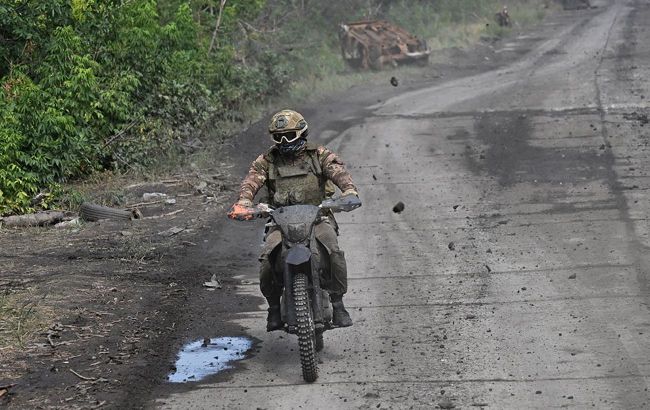'It's a new war': Russian army shifts tactics in Ukraine - The Telegraph
 Photo: Russia is changing its tactics in the war against Ukraine (Russian media)
Photo: Russia is changing its tactics in the war against Ukraine (Russian media)
Russia is throwing motorcyclists into Ukrainian trenches in an attempt to break through the defense at any cost. The tactic of rapid attacks on motorcycles is a response to a shortage of armored vehicles and the dominance of Ukrainian drones, The Telegraph reports.
Most Russian attacks fail
Since the first attempts over a year ago, most motorcycle attacks have failed - most riders are killed before reaching their target. However, the successful attacks solve a key tactical problem on the frontline in Ukraine: how to cross an open battlefield under constant air supervision - and do so quickly.
The Russian army is reportedly planning to systematically introduce motorcycles along the entire front line before new offensives.
Many lives will be lost, but valuable armored vehicles will be saved - a visible victory in the eyes of the Russian military, which has a constant flow of manpower but is forced to use outdated Soviet tanks that are unsuitable for Ukrainian battlefields.
The first reports of motorcycle units began to appear in April 2024. It started as an informal, spontaneous response to the constant drone strikes, which now kill or maim up to 70% of all soldiers and destroy more armored vehicles than all other weapons combined.
Russian motorcycle attacks surge
Since last fall, the number of Russian attacks involving motorcycles has increased significantly in northeastern Ukraine, in the Kharkiv region, and the east, in the Donetsk region, where Russia has virtually abandoned the use of armored vehicles after unacceptable losses in the winter of 2023-2024.
Russian attacks are rapid but have many flaws. For months, drones have been recording the aftermath of such failures: the outskirts of fields and Ukrainian trench lines are littered with mangled metal and burnt tires.
And it's not just motorcycles - a wide variety of unarmored vehicles are on the front lines: ATVs, civilian cars, Chinese buggies, and electric scooters.
Heavy Russian casualties
A major Russian offensive on the Ukrainian fortress of Pokrovsk on April 17 ended with the destruction of 100 Russian motorcycles, 240 Russian soldiers, and 20 armored vehicles, according to Ukrainian data.
In early May, another attack on the village of Vilne Pole in the southern Donetsk region ended in the same way, with up to 70 Russian motorcycles, 90 soldiers, and 60 vehicles destroyed by Ukrainian mines, drones, and artillery. The 110th Mechanized Brigade of Ukraine destroyed at least 20 motorcycles using drones.
"Another day – a few more burned 'iron horses'," the brigade ironically noted.
Motorcycles - the first wave
Motorcycles are usually the first phase of a multi-stage attack - they are sent in without cover to probe the defenses and exploit weaknesses before heavy equipment enters the fray.
Valerii Riabykh, Ukrainian arms analyst and editor of Defence Express, said: "The main idea here is to cut the time spent getting through the front line kill-zone, which is wider now than it was earlier in the war. While they now have fewer armoured vehicles as well as have no restriction on melting their manpower, the motorbikes are just the thing for the job," he added.
Speed vs. drones
Motorcycles can travel at about 72 km/h over rough terrain, while small drones with a first-person camera can move twice as fast. However, drones still need to reach the battlefield, while motorcyclists have a chance to reach the trenches before then.
Ukrainian military expert Pavlo Narozhnyi said: "The riders could have five to 10 minutes to storm Ukrainian trenches and attack, often outnumbering those inside." Their high speed and scattered formation make motorcycles and buggies very effective against Ukrainian artillery and drones, he added.
Massive use and depletion of defense
"They now make up 20 to 25 per cent of Russian assaults. It is hard for Ukraine to sustain such relentless attacks," said Narozhnyi, who is also the founder of Reactive Post, a nonprofit organization that supports Ukraine's artillery brigades.
Ukraine's 28th Mechanized Brigade is under the most pressure from these evolving tactics as it defends besieged Toretsk, east of the key military hub of Pokrovsk.
Brigade spokesperson Yevhen Alkhimov said: "It’s a tactic of a thousand cuts. These bike assaults are made to overload our drone units and throw as many personnel as far as possible to disturb our logistics, forcing us to spend more time, drones and ammunition to find and eliminate them."
Target is not infantry, but special forces
Individual attacks are ineffective on their own, but as part of a broader tactic to deplete and destabilize the Ukrainian defense, "they are doing their job," Alkhimov said.
Russian motorcyclists' mission is not to attack infantry, but to break deep into Ukrainian positions to attack mortar crews and drone units, which are more specialized and harder to replace. Ukrainian soldiers began to call this tactic "run, stab and escape."
Spring Russian offensive
Spring has brought improved weather conditions, allowing Russian motorcyclists to probe Ukrainian defenses almost daily. It only takes one successful attack to change a section of the front.
According to the American think tank Institute for the Study of War, Russia is using motorcycles to advance and capture as much of Ukrainian territory as possible before a possible truce, which remains uncertain.
New war on wheels
Once chaotic, the attacks are becoming more organized - motorcycle convoys are receiving electronic warfare support, and motorcycles are being equipped with 2 fighters so that if one is killed, the group can continue to move. In response to the recent successes, the Russian command is beginning to change as well.
Russia is planning to integrate motorcycle units into its military formations and may even start issuing motorcycles as standard equipment, indicating Moscow's desire to formalize and centralize their use in combat.
Under drone-controlled skies, "we will see a lot more bikes, buggies, scooters, cars at the front," Narozhnyi says. "Its a new war."
In early April, the Ukrainian Armed Forces stopped a Russian motorcycle breakthrough near Kramatorsk. Ukrainian drone operators eliminated 18 Russian motorcyclists who were trying to break through to the front lines on motorcycles, taking advantage of the foggy weather.
And in May, the Ukrainian military destroyed a Russian motorcyclist with jewelry-like precision as it was racing through Toretsk on a motorcycle.

